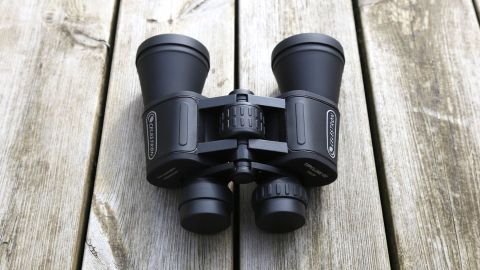Space Verdict
You’ll struggle to find a more affordable pair of roof prism binoculars for viewing the night sky with the Celestron UpClose G2 10x50’s 10x magnification and 50mm objective lenses. They’re the perfect entry-level product, though they come with caveats.
Pros
- +
Ideally sized for astronomy
- +
Easy to adjust
- +
Reasonably lightweight
- +
Very affordable
Cons
- -
Minor image distortion
- -
Narrow eye cups
- -
Poor objective lens caps
- -
Minimal eye relief
Why you can trust Space.com
How much should you pay for a pair of binoculars? Though some of the best binoculars go for low prices, you would do well to find many pairs of astronomy-centric binoculars as affordable as the Celestron UpClose G2 10x50.
The pandemic has sparked an interest in home-bound activities like stargazing and there are plenty of reasons why a pair with the exact specifications of the UpClose G2 10x50 are just what the budding amateur astronomer needs.
Magnification: 10x
Objective lens diameter: 50mm
Angular field of view: 6.8°
Eye relief: 12mm
Weight: 27 oz
All binoculars are a balance between magnification (power) and aperture (the amount of light they collect). The Celestron UpClose G2 10x50 boast 10x magnification, which is just about perfect for a wide field of view of the night sky, while their 50 mm diameter objective lenses let in enough light at night.
Whether they actually deliver on those theoretical advantages is down to the optical design, which in the Celestron UpClose G2 10x50 consists of a Porro prism (wide with tapered barrels) as opposed to the roof prism (H-shaped with narrow barrels). Porro prisms are generally favored for astronomy because they’re simpler optical systems and are more affordable. That’s obviously the case with the UpClose G2 10x50, which boast such an aggressively low price that they could be an option for astronomy groups and star parties after several pairs of affordable and dependable binoculars for long-term use. However, since build quality is best described as basic, we’re not convinced the Celestron UpClose G2 10x50 will last as long as pricier options.
If you do decide to buy the UpClose G2 10x50, be really careful when choosing because Celestron sells a dizzying array of different products in the UpClose G2 range. There are various magnifications, objective lens sizes and prism types, with even a monocular and zoom lens offered.
Celestron UpClose G2 10x50 review: Design
- Aluminum frame
- Water-resistant
- Bk7 Porro prisms
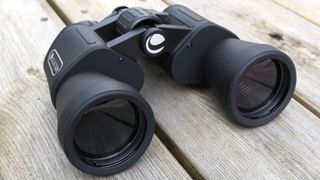
The UpClose G2 10x50’s design and build quality are best described as basic. Fashioned from aluminum with a matte rubber covering, they’re water-resistant rather than waterproof. They're not nitrogen-purged, so it's possible they could get fogged-up on occasion. Such niceties are for higher-end products. We also noticed a slight loose-ness to the eyecups that could easily prove a weak point if these binoculars were to be dropped.
Optically speaking the Celestron UpClose G2 10x50 are a compromise – as all binoculars are – with their Porro prisms dove-tailing with Bk7 glass, which plays second fiddle to BaK-4 for light transmission in the world of binoculars. That’s also standard at this very low price.
Carrying case
Objective lens caps
Eyepiece covers
Lens cloth
In practice, there are a few downsides to the Celestron UpClose G2 10x50’s design. They aren’t as light to hold as some roof prism binoculars, and despite the presence of some useful thumb indents and finger ridges, they are noticeably wider, too.
However, in use what the UpClose G2 10x50 mostly lacks is eye-relief. The distance from your eye to the glass of the eyepiece is important to be able to see everything in the field of view, especially if you wear spectacles. That distance is called eye relief and it’s typically between 10mm and 20mm (and often adjustable within that range) in pricier binoculars. Here it’s fixed at just 12mm, while the static eyecups also feel a little narrow. So, if you wear spectacles, avoid the UpClose G2 10x50. However, if you don’t, you’ll see enough of its 6.8° field of view, though the eyecups aren’t particularly comfortable over long periods of time.
The low price also means low-quality accessories, which here comprise very simple (and highly losable) detachable lens caps for both the eyecups and the objective lenses, and a basic carry case that includes a shoulder strap but lacks padding. Overall it’s a very budget-conscious package, but optically speaking, there’s much to like about the Celestron UpClose G2 10x50.
Celestron UpClose G2 10x50 review: Performance
- Bright and colorful images
- Slight edge distortion
- Some glare and artifacts from Moon
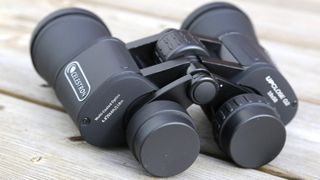
Are the Celestron UpClose G2 10x50 the perfect affordable choice of binoculars for observing the night sky? Their 10x50 specification is the sweet spot for astronomy, but a few design and image foibles at night make them less than ideal.
The poor lens caps are to be expected at this low price, while the static eyecup’s lack of eye relief should bother only spectacles-wearers.
The chief issue with the UpClose G2 10x50 is consistent sharpness, which is easy to achieve in the center of the field of view, but less so at the edges. A slight blur is detectable, although it's not a huge issue when stargazing at celestial objects. In our tests, they gave us excellent views of the Pleiades star cluster, Jupiter and its giant moons, and the intensely bright red star Aldebaran in Taurus. With the Celestron UpClose G2 10x50 on a tripod we even managed to pick out the tiny asteroid Ceres close by, and even the planet Uranus on the night of its annual opposition. On the bridge between the objective lenses, there’s a standard binocular tripod thread, though an L-shaped tripod adapter bracket is also required.
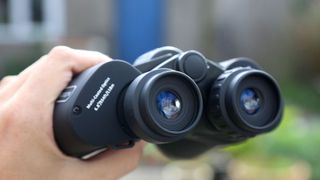
What we didn’t notice – and had expected to – was chromatic aberration, which often shows up in affordable binoculars as a purplish line around high-contrast objects like the Moon. Kudos to Celestron and the multi-coated lenses in use here. However, we did notice that a bright Moon – and, indeed, any artificial lights – do tend to cause some glare and artifacts within the prisms.
Although the rubber-armored aluminum housing is water-resistant, the Celestron UpClose G2 10x50 aren’t waterproof and haven’t been nitrogen-purged. As a consequence, they could fog up slightly in the cold, though they were fine during a two-hour session in near-freezing conditions.
Their 10x magnification gives a very wide field of view that’s ideal for looking within constellations and scanning the Milky Way without going too deep, but it’s hardly surprising that the UpClose G2 10x50 do feature a few imperfections.
Should you buy the Celestron UpClose G2 10x50 binoculars?
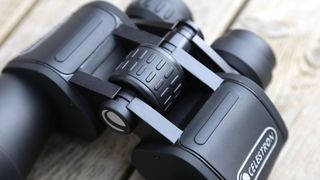
Stargazers just starting out too often overlook binoculars, instead purchasing a telescope as soon as they possibly can. That’s a huge mistake. All experienced amateur astronomers sing the praises of a good pair of binoculars, and though the Celestron UpClose G2 10x50 do little more than meet the minimum requirements, they will suit beginners well.
In theory, they’re perfect, with the UpClose G2 10x50’s exact optical specifications favored by amateur astronomers. The UpClose G2 10x50 are best thought of as a great value pair of entry-level binoculars for all-round use and for occasional night sky views. If you’ve never looked at the night sky through a pair of reasonably powerful binoculars then the UpClose G2 10x50 will give you that ‘wow’ moment as you scan the star fields of the Milky Way. They’re also really easy to set up, adjust and use. As such, there is a reasonably good choice for astronomy groups on a budget (though we do worry about their longevity). However, if you know the night sky well and you've used many pairs of binoculars, the Celestron UpClose G2 10x50 are unlikely to impress you. Slight foibles include some poor lens caps, a lack of eye relief and some glare from bright light.
If you can live with these slight issues then the Celestron UpClose G2 10x50 are worth considering, but don’t expect the ultimate in build quality, comfort and convenience. For those things, you’re going to have to spend a little more; we've included other options for different budgets in our best binoculars guide.
If the Celestron UpClose G2 10x50 isn’t for you

There's no doubting that 10x50 binoculars are the ideal specification for stargazing, being both portable and able to let in enough light in the dark, but you can – and maybe should – spend a bit more than Celestron is asking for its UpClose G2 10x50 if the night sky is your primary target.
The Opticron Adventurer II WP 10x50 are roof prism binoculars with higher quality optics, as are the Celestron TrailSeeker 8x42, which offer a slightly wider field of view. For a real treat head straight for with the Canon 10x42L IS WP, which come complete with image stabilization, or the Celestron SkyMaster 25x100 binoculars, which need to be mounted on a tripod but will give you exceptional close-ups of deep-sky objects.
Join our Space Forums to keep talking space on the latest missions, night sky and more! And if you have a news tip, correction or comment, let us know at: community@space.com.

Jamie is an experienced science, technology and travel journalist and stargazer who writes about exploring the night sky, solar and lunar eclipses, moon-gazing, astro-travel, astronomy and space exploration. He is the editor of WhenIsTheNextEclipse.com and author of A Stargazing Program For Beginners, and is a senior contributor at Forbes. His special skill is turning tech-babble into plain English.
